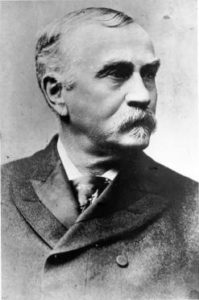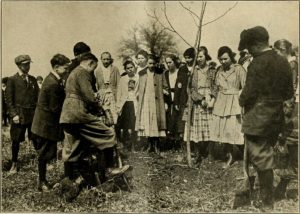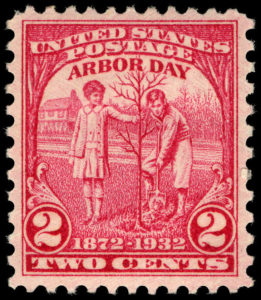Arbor Day is a tree-planting rite of spring in all fifty states and in many countries around the world. The date of celebration varies according to the ideal time to plant new trees, but the first Arbor Day was celebrated on April 10, 1872
J. Sterling Morton (born in 1832), a journalist and nature lover, moved to the Nebraska Territory from Michigan in 1854. He and his wife, Carrie, missed the abundant trees of their earlier home, so they planted their 160 acres of grassland with trees, bushes and flowers. Morton became the editor of a newspaper in Nebraska City, and later Secretary of the Nebraska Territory. He used his prominent position to promote interest in agriculture and the environment, especially tree planting.

Nebraska became a state in 1867, and Morton was named to the state board of agriculture. He convinced his colleagues to create a day to encourage Nebraskans to plant trees. The board wanted to call it Sylan Day, emphasizing forests, but Morton held out for Arbor Day, to recognize that trees everywhere, not just in forests, had great value. Morton won, and the first Arbor Day was celebrated on April 10, 1872. Participants across the state planted more than one million trees!

Just like the trees they planted, Arbor Day kept growing. By 1882, schools across the country were participating, and by 1892, every state except Delaware had created its own Arbor Day (today, all fifty states celebrate Arbor Day). Countries around the world began their own Arbor Day celebration, with Japan leading the way in 1883. The Arbor Day website lists 33 countries with national celebrations.
J. Sterling Morton’s status grew along with his tree planting holiday. He became U.S. Secretary of Agriculture under Grover Cleveland, from 1893-1897. As secretary, he was influential in creating the first national forest preserves. Later, his son created the Morton Arboretum, outside Chicago, now one of the world’s foremost botanical reserves and research institutions. In 1970, President Nixon created National Arbor Day, celebrated on the last Friday in April.

On the 100th anniversary of the first Arbor Day, the Arbor Day Foundation was established to continue and expand the work of tree planting and conservation around the U.S. and the globe. The foundation has more than one million members and donors. The group gives out more than 4 million seedlings each year as part of Arbor Day ceremonies. It engages in a series of projects, to encourage tree plantings in cities, re-establish forests, improve the condition of street trees, teach students about trees and nature, and develop disease-resistant hybrids of imperiled species. They are currently deeply involved in genetic crossing and testing of hazelnut cultivars, seeking those that are blight resistant and adaptable to a wide range of environmental conditions.
Arbor Day, according to its founder, is not like other holidays: “Each of those reposes on the past, while Arbor Day proposes the future.” So, be on the lookout for Arbor Day celebrations in your state and community, and remember the motto of the Morton family: “Plant Trees!”
References:
Arbor Day Foundation. 2017. 2017 Annual Report. Available at: https://www.arborday.org/generalinfo/annualreport/documents/2017-annual-report.pdf. Accessed April 9, 2018.
Arbor Day Foundation. The History of Arbor Day. Available at: https://www.arborday.org/celebrate/history.cfm. Accessed April 9, 2018.
History.com. History of Arbor Day. Available at: https://www.history.com/topics/the-history-of-arbor-day. Accessed April 9, 2018.
Nebraskastudies.org. J. Sterling Morton. Available at: http://www.nebraskastudies.org/0500/frameset_reset.html?http://www.nebraskastudies.org/0500/stories/0506_0100.html. Accessed April 9, 2018.
The Morton Arboretum. Arbor Day History. Available at: http://www.mortonarb.org/visit-explore/about-arboretum/mission-and-history/arbor-day-history. Accessed April 9, 2018
